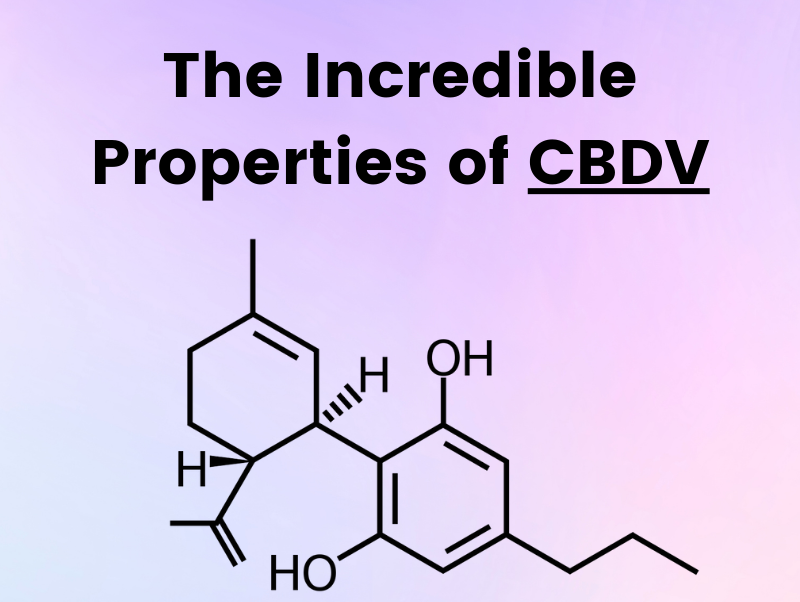
Thought botanicals are all about chasing “head buzz” THC highs? Think again. Cannabis is an incredibly complex plant, made up of more than 100 chemical compounds known as cannabinoids. Cannabidivarin (CBDV) is one of the latest cannabinoids to capture headlines, intriguing not only recreational consumers but also big pharma companies developing treatments for conditions like Crohn’s disease and epilepsy.
Unlike THC, this non-psychoactive cannabinoid won’t send you into a state of euphoria. Instead, it interacts with the body’s natural endocannabinoid system (ECS) to deactivate nerve cells and deliver a myriad of physiological benefits. No doubt about it, this humble cannabinoid has big potential. Read on to find out more about the science behind CBDV and what’s next for the cannabinoid.
Getting to know CBDV
We always like to get a little nerdy when it comes to cannabinoids, and CBDV is no exception. To really understand how this neat chemical compound works, you’ll need to do a little groundwork. For starters, CBDV is a homolog of cannabidiol which means it shares the same chemical structure as CBD but with a few small differences. Both cannabinoids have 30 stereoisomers and seven double bond isomers, though CBDV features a shortened side chain with two less methylene bridges than CBD.
Will CBDV get me high?
Short answer, nope. While CBDV is a powerful cannabinoid, it doesn’t have the psychoactive properties of counterparts like THC. Instead, it offers a range of neuroprotective and anti-inflammatory benefits and promises similar benefits to its mellow cousin, CBD.
CBDV in the medical realm
Like many cannabinoids before it, CBDV has made quite an impression in the medical realm. One of the most exciting applications is its potential to reduce the frequency and intensity of seizures. Research suggests it does this by modifying the neurochemical pathway of TRPV1, a capsaicin receptor that promotes epileptic activity in the brain and triggers seizures.
“These results provide the first molecular confirmation of behaviorally observed effects of the non-psychoactive, anticonvulsant cannabinoid, CBDV, upon chemically-induced seizures and serve to underscore its suitability for clinical development,” reads a scientific study exploring the anticonvulsant properties of CBDV.
With so much potential, it’s no wonder global cannabinoid-based medicine company GW Pharmaceuticals is currently developing a CBDV-based treatment for seizures.
CBDV has excellent anti-nausea properties, with research suggesting the cannabinoid acts as an antagonist to CB1 receptors. This interaction actively blocks nausea neurotransmitters in the brain and makes CBDV the cannabinoid of choice for treating a wide range of conditions. A known anti-inflammatory, CBDV has emerged as a useful treatment for Crohn’s disease, an inflammatory condition that affects the bowel and digestive tract. Powerful neuroprotective properties have also positioned CBDV as a possible therapy for patients diagnosed with Multiple Sclerosis, a disease that affects the brain and spinal cord.
How to enjoy CBDV
A naturally occurring cannabinoid, CBDV content varies between strains. It’s more prevalent in Indica strains from Africa and Asia, as well as strains with low THC concentrations. You’ll also find CBDV in strains that are naturally rich in CBD.
With CBD to THC ratios as high as 100:1, hemp-based cannabis strains are a wonderful source of CBDV. Under the 2018 Farm Bill, federally legal hemp must contain THC content of 0.3% of less. This ultra-low THC content makes it a naturally rich source of CBDV.
What’s next for CBDV?
While CBDV was discovered back in the 1960s, it’s only recently that the cannabinoid has started to get the attention it deserves. New technologies have made it easier than ever to isolate cannabinoids like CBDV and harness their unique therapeutic properties. Some companies are working on engineering CBDV cannabis seed varieties, with the potential for cannabidivarin content as high as 6%. Big pharma giants like GW Pharmaceutical are also spearheading the cannabidivarin movement, with clinical trials delivering promising results for the CBDV-based medications.
Such keen interest from pharmaceutical titans like GW Pharmaceutical proves that cannabis is so much more than a recreational drug. With the potential to treat conditions like Crohn’s and epilepsy, cannabinoids like CBDV are earning their place as genuine medications used not only by long-haired hippies, but patients around the world.
Cannessentials and CBDV
We’re always on the hunt for new products to add to the Cannessentials family and you can bet CBDV is on our radar. Watch this space!
In the meantime, we have a huge range of premium quality CBD products that offer a very similar experience to CBDV. Whether you’re on the search for a mellow and myrcene-rich hemp flower, a potent CBD-infused tincture or a luxurious CBD balm packed with natural goodness, we have you covered.
Still looking for inspiration? Here’s a quick look at some of our CBD-rich faves that simulate the benefits of CBDV:
Elektra Hemp Flower
Mellow and fruity, Elektra Hemp Flower promises that indica-heavy experience you know and love. Made with a combination of ACDC and Early Resin Berry, this strain is packed with CBD and is high in a terpene called myrcene, which adds to the rich, peppery aromas you’ll enjoy with Elektra Hemp Flower. With a total CBD content of 19.5%, this strain is designed to soothe and relax.
Hawaiian Haze Hemp Flower
Tropical and tasty, Hawaiian Haze is one of our all-time favorite CBD-rich strains. Expect an energizing and uplifting high, with the cannabinoids and terpenes acting fast to melt away anxiety without compromising your focus. This makes it a great social strain, as well as a great option for consumers who want to address issues like anxiety and depression. The flavor profile is divine, with hints of mango, pepper, pine, citrus and of course, its namesake pineapple. This beauty is made up mostly of Indica strains, making it a bona fide relaxant with high CBD content.

